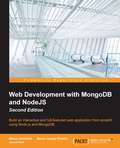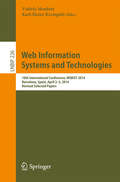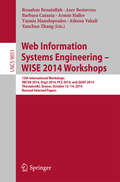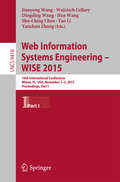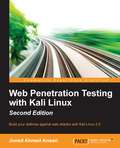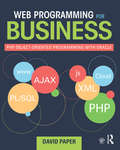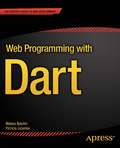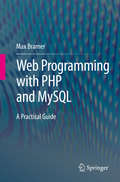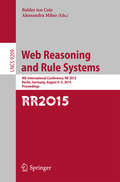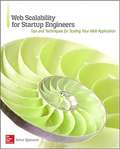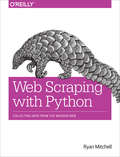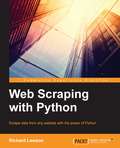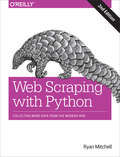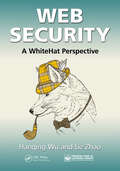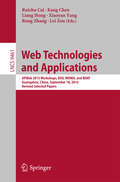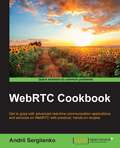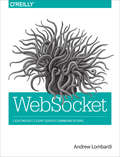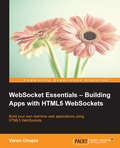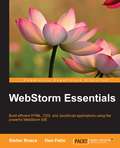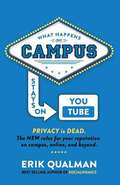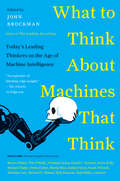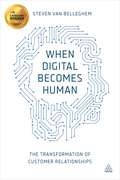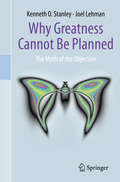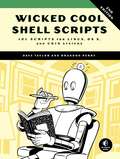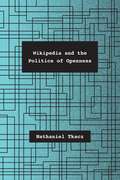- Table View
- List View
Web Development with MongoDB and NodeJS - Second Edition
by Jason Krol Bruno Joseph D'Mello Mithun SatheeshBuild an interactive and full-featured web application from scratch using Node.js and MongoDBAbout This BookConfigure your development environment to use Node.js and MongoDBUse Node.js to connect to a MongoDB database and perform data manipulationsA practical guide with clear instructions to design and develop a complete web application from start to finishWho This Book Is ForThis book is designed for JavaScript developers of any skill level that want to get up and running using Node.js and MongoDB to build full-featured web applications. A basic understanding of JavaScript and HTML is the only requirement for this book.What You Will LearnConfigure your development environment to use Node.js and MongoDBWrite and configure a web server using Node.js powered by the Express.js frameworkBuild dynamic HTML pages using the Handlebars template enginePersist application data using MongoDB and Mongoose ODMTest your code using automated testing tools such as the Mocha frameworkDeploy the development environment to the cloud using services such as Heroku, Amazon Web Services, and Microsoft AzureExplore Single-Page application frameworks to take your web applications to the next levelIn DetailNode.js and MongoDB are quickly becoming one of the most popular tech stacks for the web. Powered by Google's V8 engine, Node.js caters to easily building fast, scalable network applications while MongoDB is the perfect fit as a scalable, high-performance, open source NoSQL database solution. Using these two technologies together, web applications can be built quickly and easily and deployed to the cloud with very little difficulty.The book will begin by introducing you to the groundwork needed to set up the development environment. Here, you will quickly run through the steps necessary to get the main application server up and running. Then you will see how to use Node.js to connect to a MongoDB database and perform data manipulations.From here on, the book will take you through integration with third-party tools for interaction with web apps. It then moves on to show you how to use controllers and view models to generate reusable code that will reduce development time. Toward the end of the book, we will cover tests to properly execute the code and some popular frameworks for developing web applications.By the end of the book, you will have a running web application developed with MongoDB and Node.js along with it's popular frameworks.Style and approachAn easy guide to Node.js and MongoDB, which will quickly introduce you to the relevant concepts by taking you through the different steps involved in building a full-fledged web application.
Web Information Systems and Technologies
by Karl-Heinz Krempels Valérie MonfortThis bookconstitutes revised selected papers from the 10th InternationalConference on Web Information Systems and Technologies, WEBIST 2014, held inBarcelona, Spain, April 2014, organized by the Institute for Systems andTechnologies of Information, Control and Communication (INSTICC), andtechnically sponsored by the European Research Center for Information Systems(ERCIS). The purposeof the WEBIST series of conferences is to bring together researches, engineersand practitioners interested in technological advances and businessapplications of web-based information systems. The 21papers presented in this volume were carefully reviewed and selected originally153 paper submissions. They were organized in topical sections names, internettechnology; web interfaces and applications; society, e-business ande-government; web intelligence; and mobile information systems. The book alsocontains two invited talks in full-paper length.
Web Information Systems Engineering - WISE 2014 Workshops
by Boualem Benatallah Azer Bestavros Barbara Catania Armin Haller Yannis Manolopoulos Athena Vakali Yanchun ZhangThis book constitutes the revised selected papers of the combined workshops on Web Information Systems Engineering, WISE 2014, held in Thessaloniki, Greece, in October 2014. The 19 selected papers presented were carefully revised and report from the four workshops: computational social networks, IWCSN 2014, enterprise social networks, Org2 2014, personalization and context-awareness in cloud and service computing, PCS 2014, and data quality and trust in big data, QUAT 2014.
Web Information Systems Engineering - WISE 2015
by Yanchun Zhang Tao Li Shu-Ching Chen Hua Wang Dingding Wang Wojciech Cellary Jianyong WangThis two volume set LNCS 9418 and LNCS 9419 constitutes the proceedings of the 16th International Conference on Web Information Systems Engineering, WISE 2015, held in Miami, FL, USA, in November 2015. The 53 full papers, 17 short and 14 special sessions and invited papers, presented in these proceedings were carefully reviewed and selected from 189 submissions. The papers cover the areas of big data techniques and applications, deep/hidden web, integration of web and internet, linked open data, semantic web, social network computing, social web and applications, social web models, analysis and mining, web-based applications, web-based business processes and web services, web data integration and mashups, web data models, web information retrieval, web privacy and security, web-based recommendations, and web search.
Web Penetration Testing with Kali Linux - Second Edition
by Juned Ahmed AnsariBuild your defense against web attacks with Kali Linux 2.0 About This Book * Gain a deep understanding of the flaws in web applications and exploit them in a practical manner * Get hands-on web application hacking experience with a range of tools in Kali Linux 2.0 * Develop the practical skills required to master multiple tools in the Kali Linux 2.0 toolkit Who This Book Is For If you are already working as a network penetration tester and want to expand your knowledge of web application hacking, then this book tailored for you. Those who are interested in learning more about the Kali Sana tools that are used to test web applications will find this book a thoroughly useful and interesting guide. What You Will Learn * Set up your lab with Kali Linux 2.0 * Identify the difference between hacking a web application and network hacking * Understand the different techniques used to identify the flavor of web applications * Expose vulnerabilities present in web servers and their applications using server-side attacks * Use SQL and cross-site scripting (XSS) attacks * Check for XSS flaws using the burp suite proxy * Find out about the mitigation techniques used to negate the effects of the Injection and Blind SQL attacks In Detail Kali Linux 2.0 is the new generation of the industry-leading BackTrack Linux penetration testing and security auditing Linux distribution. It contains several hundred tools aimed at various information security tasks such as penetration testing, forensics, and reverse engineering. At the beginning of the book, you will be introduced to the concepts of hacking and penetration testing and will get to know about the tools used in Kali Linux 2.0 that relate to web application hacking. Then, you will gain a deep understanding of SQL and command injection flaws and ways to exploit the flaws. Moving on, you will get to know more about scripting and input validation flaws, AJAX, and the security issues related to AJAX. At the end of the book, you will use an automated technique called fuzzing to be able to identify flaws in a web application. Finally, you will understand the web application vulnerabilities and the ways in which they can be exploited using the tools in Kali Linux 2.0. Style and approach This step-by-step guide covers each topic with detailed practical examples. Every concept is explained with the help of illustrations using the tools available in Kali Linux 2.0.
Web Programming for Business: PHP Object-Oriented Programming with Oracle
by David PaperWeb Programming for Business: PHP Object-Oriented Programming with Oracle focuses on fundamental PHP coding, giving students practical, enduring skills to solve data and technical problems in business. Using Oracle as the backend database, the book is version-neutral, teaching students code that will still work even with changes to PHP and Oracle. The code is clean, clearly explained and solutions-oriented, allowing students to understand how technologies such as XML, RSS or AJAX can be leveraged in business applications. The book is fully illustrated with examples, and includes chapters on: Database functionality Security programming Transformation programming to move data Powerpoint slides, applied exam questions, and the raw code for all examples are available on a companion website. This book offers an innovative approach that allows anyone with basic SQL and HTML skills to learn PHP object-oriented programming.
Web Programming with Dart
by Moises Belchin Patricia JuberiasWeb Programming with Dart is for programmers who want to master the new Dart programming language from Google, and also web developers who want to understand how Dart can integrate perfectly with HTML5 and CSS3. With this book you will understand the ins and outs of the language, how the tools work, and how to get the most from the core functions and libraries. Web Programming with Dart is a practical, example-led book, with case studies involving developing UI animations for the web, working with web services such as JSON, server side Dart applications, and the new Polymer. dart library for advanced HTML UI web components generation. Take a full tour of Dart's core features and its advanced functionalityLearn the tools that come with Dart SDK and the most important libraries. Additionally you will work with the newest Polymer. dart library for web component creation. Develop your own command-line and server side applications and, of course, web applications with Dart.
Web Programming with PHP and MySQL
by Max BramerIntroductory textbook covering all the main features of the 'web programming' languages PHP and MySQL together with detailed examples that will enable readers (whether students on a taught course or independent learners) to use them to create their own applications or understand existing ones. A particular focus is the use of PHP to generate MySQL commands from a script as it is executed. Each chapter includes aims, a summary and practical exercises (with solutions) to support learning. Chapters are designed to stand alone as far as possible, so that they can be studied independently of the rest of the text by those with some previous knowledge of the languages. There is a comprehensive glossary of technical terms, together with extensive appendices for quick reference of language features.
Web Reasoning and Rule Systems
by Balder Ten Cate Alessandra MileoThis book constitutes the refereed proceedings of the 9th International Conference on Web Reasoning and Rule Systems, RR 2015, held in Berlin, Germany, in August 2015. The 5 full papers, 4 technical communications presented together with 4 invited talks were carefully reviewed and selected from 16 submissions. The scale and the heterogenous nature of web data poses many challenges, and turns basic tasks such as query answering and data transformations into complex reasoning problems. Rule-based systems have found many applications in this area. The RR conference welcomes original research from all areas of Web Reasoning and Rule Systems. Topics of particular interest are: answer set programming, complex events, datalog, description logics, event-condition-action rules, information extraction, and logic programming.
Web Scalability for Startup Engineers
by Artur EjsmontThis is an invaluable roadmap for meeting the rapid demand to deliver scalable applications in a startup environment. With a focus on core concepts and best practices rather than on individual languages, platforms, or technologies, Web Scalability for Startup Engineers describes how infrastructure and software architecture work together to support a scalable environment. <p><p> You’ll learn, step by step, how scalable systems work and how to solve common challenges. Helpful diagrams are included throughout, and real-world examples illustrate the concepts presented. Even if you have limited time and resources, you can successfully develop and deliver robust, scalable web applications with help from this practical guide. <p><p> Learn the key principles of good software design required for scalable systems Build the front-end layer to sustain the highest levels of concurrency and request rates Design and develop web services, including REST-ful APIs; Enable a horizontally scalable data layer Implement caching best practices; Leverage asynchronous processing, messaging, and event-driven architecture; Structure, index, and store data for optimized search; Explore other aspects of scalability, such as automation, project management, and agile teams.
Web Scraping with Python
by Ryan MitchellLearn web scraping and crawling techniques to access unlimited data from any web source in any format. With this practical guide, you'll learn how to use Python scripts and web APIs to gather and process data from thousands--or even millions--of web pages at once.Ideal for programmers, security professionals, and web administrators familiar with Python, this book not only teaches basic web scraping mechanics, but also delves into more advanced topics, such as analyzing raw data or using scrapers for frontend website testing. Code samples are available to help you understand the concepts in practice.Learn how to parse complicated HTML pagesTraverse multiple pages and sitesGet a general overview of APIs and how they workLearn several methods for storing the data you scrapeDownload, read, and extract data from documentsUse tools and techniques to clean badly formatted dataRead and write natural languagesCrawl through forms and loginsUnderstand how to scrape JavaScriptLearn image processing and text recognition
Web Scraping with Python
by Richard PenmanThis book is aimed at developers who want to use web scraping for legitimate purposes. Prior programming experience with Python would be useful but not essential. Anyone with general knowledge of programming languages should be able to pick up the book and understand the principals involved.
Web Scraping with Python: Collecting More Data from the Modern Web
by Ryan MitchellIf programming is magic then web scraping is surely a form of wizardry. By writing a simple automated program, you can query web servers, request data, and parse it to extract the information you need. The expanded edition of this practical book not only introduces you web scraping, but also serves as a comprehensive guide to scraping almost every type of data from the modern web.Part I focuses on web scraping mechanics: using Python to request information from a web server, performing basic handling of the server’s response, and interacting with sites in an automated fashion. Part II explores a variety of more specific tools and applications to fit any web scraping scenario you’re likely to encounter.Parse complicated HTML pagesDevelop crawlers with the Scrapy frameworkLearn methods to store data you scrapeRead and extract data from documentsClean and normalize badly formatted dataRead and write natural languagesCrawl through forms and loginsScrape JavaScript and crawl through APIsUse and write image-to-text softwareAvoid scraping traps and bot blockersUse scrapers to test your website
Web Security: A WhiteHat Perspective
by Hanqing WuIn late 2013, approximately 40 million customer debit and credit cards were leaked in a data breach at Target. This catastrophic event, deemed one of the biggest data breaches ever, clearly showed that many companies need to significantly improve their information security strategies. Web Security: A White Hat Perspective presents a comprehensive g
Web Technologies and Applications
by Ruichu Cai Kang Chen Liang Hong Xiaoyan Yang Rong Zhang Lei ZouThis bookconstitutes the refereed proceedings of the workshops held at the 17thAsia-Pacific Web Conference, APWeb 2015, in Guangzhou, China, in September2015. The 15 fullpapers were carefully reviewed and selected from various submissions. The volumepresents the papers that have been accepted for the following workshops: BigData Applications in Telecoms, BDAT 2015, Big Social Data, BSD 2015, and WebData Mining and Applications, WDMA 2015. The papers cover various issues in thearea of the World Wide Web with the underlying technologies and applications.
WebRTC Cookbook
by Andrii SergiienkoIf you are a JavaScript developer with a basic knowledge of WebRTC and software development, but want to explore how to use it in more depth, this book is for you.
WebSocket: Lightweight Client-Server Communications
by Andrew LombardiUntil recently, creating desktop-like applications in the browser meant using inefficient Ajax or Comet technologies to communicate with the server. <P><P>With this practical guide, you'll learn how to use WebSocket, a protocol that enables the client and server to communicate with each other on a single connection simultaneously. No more asynchronous communication or long polling!For developers with a good grasp of JavaScript (and perhaps Node.js), author Andrew Lombardi provides useful hands-on examples throughout the book to help you get up to speed with the WebSocket API. You'll also learn how to use WebSocket with Transport Layer Security (TLS).Learn how to use WebSocket API events, messages, attributes, and methods within your client applicationBuild bi-directional chat applications on the client and server with WebSocket as the communication layerCreate a subprotocol over WebSocket for STOMP 1.0, the Simple Text Oriented Messaging ProtocolUse options for older browsers that don't natively support WebSocketProtect your WebSocket application against various attack vectors with TLS and other toolsDebug applications by learning aspects of the WebSocket lifecycle
WebSocket Essentials – Building Apps with HTML5 WebSockets
by Varun ChopraThis book is for web developers who want to learn and implement WebSocket to create interesting apps for modern browsers, leveraging the capabilities of HTML5 with WebSockets.
WebStorm Essentials
by Den Patin Stefan RoscaBuild efficient HTML, CSS and JavaScript applications using the powerful WebStorm IDEAbout This BookGet to grips with the newest features of WebStormUse WebStorm to simplify your web development process and improve its efficiencyBest practices and cutting-edge technologies for JavaScript developmentWho This Book Is ForIf you are a web developer who is new to WebStorm, this is the book for you. Knowledge of languages such as JavaScript, HTML, and CSS is assumed, with a reasonable understanding of frameworks such as AngularJS, Node.js, and Meteor.What You Will LearnInstall and configure WebStorm to suit your workflowDevelop mobile applications using web technologies with WebStormCreate simple web pages with the help of templatesImprove your web development efficiency with WebStorm's built-in featuresAnalyse and debug your code in WebStormPerform unit testing and debugging in WebStorm to test your applicationsGet to grips with the latest version of WebStorm (WebStorm 10) to revolutionize your web development experienceIn DetailJetBrains WebStorm is a commercial and powerful IDE, perfectly equipped for complex client-side development and server-side development with Node.js. It provides first-class support for JavaScript, Node.js, HTML, and CSS. WebStorm is the number one choice for developing web applications due to its advanced features and integration with a plethora of topical technologies such as Meteor and Gulp.This book will be your companion in building high-quality web applications using WebStorm, taking advantage of the newest features of Webstorm 10.You will start with an introduction to the latest features of WebStorm and its interface, followed by learning how to set up a new project with the help of templates. You will then build a web application using AngularJS, ReactJs, Node.js, Express, and Meteor. This book will also show you how to use pioneering HTML5 technologies in mobile application development and package managers, as well as how to build automation tools for your application. Finally, you will discover how to perform debugging, tracing, profiling, and code style checking activities directly in WebStorm, followed by testing your application inside WebStorm, using some of the most popular testing libraries out there.By the end of this book, you will have a solid understanding of how to develop powerful web applications quickly and easily with WebStorm.Style and approachThis book is a hands-on guide to getting to grips with WebStorm, complete with plenty of screenshots and tips. New features are introduced to you with the help of sample applications.
What Happens on Campus Stays on YouTube: Privacy Is Dead. The New Rules For Your Reputation On Campus, Online And Beyond
by Erik QualmanWhether we like it, love it, use it or hate it, escaping social media on any college campus is nearly impossible. When you arrive on campus, you will notice that social media isn't just a way to connect with friends but also a vast communication and marketing network for student organizations, internship opportunities and more! The purpose of this book is to not to tell you to avoid social media, but to help you start thinking about your digital reputation and providing you with some expert advice on using social media in a smart way. Even if you don't want to dive in right now, keep this book on your shelf for your future reference.
What to Think About Machines That Think: Today's Leading Thinkers on the Age of Machine Intelligence
by Mr John BrockmanAs the world becomes ever more dominated by technology, John Brockman’s latest addition to the acclaimed and bestselling “Edge Question Series” asks more than 175 leading scientists, philosophers, and artists: What do you think about machines that think? <P><P> The development of artificial intelligence has been a source of fascination and anxiety ever since Alan Turing formalized the concept in 1950. Today, Stephen Hawking believes that AI “could spell the end of the human race.” At the very least, its development raises complicated moral issues with powerful real-world implications—for us and for our machines. <P> In this volume, recording artist Brian Eno proposes that we’re already part of an AI: global civilization, or what TED curator Chris Anderson elsewhere calls the hive mind. And author Pamela McCorduck considers what drives us to pursue AI in the first place. <P> On the existential threat posed by superintelligent machines, Steven Pinker questions the likelihood of a robot uprising. Douglas Coupland traces discomfort with human-programmed AI to deeper fears about what constitutes “humanness.” Martin Rees predicts the end of organic thinking, while Daniel C. Dennett explains why he believes the Singularity might be an urban legend.
When Digital Becomes Human
by Steven Van BelleghemIn an age when customers have access to vast amounts of data about a company, its product and its competitors, customer experience becomes increasingly important as a sustainable source of competitive advantage. But success doesn't just rely on digital engagement and excellence, but also on combining a digital-first attitude with a human touch. In When Digital Becomes Human, Steven Van Belleghem explores and explains the new digital relationships. Packed with global examples from organizations that have successfully transformed their customer relationships, such as Amazon, Toyota, ING, Coolblue, Nike and Starbucks, When Digital Becomes Human presents a clear model that companies can easily implement to integrate an emotional layer into their digital strategy. This guide to combining two of a business's most important assets - its people and its digital strengths - covers the latest issues in digital marketing and customer experience management, including omnichannel and multichannel experiences, big data and predictive analytics, privacy concerns, customer collaboration (ie crowdsourcing) and more.
Why Greatness Cannot Be Planned
by Kenneth O. Stanley Joel LehmanWhy does modern life revolve around objectives? From how science is funded, to improving how children are educated -- and nearly everything in-between -- our society has become obsessed with a seductive illusion: that greatness results from doggedly measuring improvement in the relentless pursuit of an ambitious goal. In Why Greatness Cannot Be Planned, Stanley and Lehman begin with a surprising scientific discovery in artificial intelligence that leads ultimately to the conclusion that the objective obsession has gone too far. They make the case that great achievement can't be bottled up into mechanical metrics; that innovation is not driven by narrowly focused heroic effort; and that we would be wiser (and the outcomes better) if instead we whole-heartedly embraced serendipitous discovery and playful creativity. Controversial at its heart, yet refreshingly provocative, this book challenges readers to consider life without a destination and discovery without a compass.
Wicked Cool Shell Scripts, 2nd Edition: 101 Scripts for Linux, OS X, and UNIX Systems
by Dave Taylor Brandon PerryShell scripts are an efficient way to interact with your machine and manage your files and system operations. With just a few lines of code, your computer will do exactly what you want it to do. But you can also use shell scripts for many other essential (and not-so-essential) tasks.This second edition of Wicked Cool Shell Scripts offers a collection of useful, customizable, and fun shell scripts for solving common problems and personalizing your computing environment. Each chapter contains ready-to-use scripts and explanations of how they work, why you&’d want to use them, and suggestions for changing and expanding them. You'll find a mix of classic favorites, like a disk backup utility that keeps your files safe when your system crashes, a password manager, a weather tracker, and several games, as well as 23 brand-new scripts, including:– ZIP code lookup tool that reports the city and state – Bitcoin address information retriever – suite of tools for working with cloud services like Dropbox and iCloud – for renaming and applying commands to files in bulk – processing and editing toolsWhether you want to save time managing your system or just find new ways to goof off, these scripts are wicked cool!
Wikipedia and the Politics of Openness
by Nathaniel TkaczFew virtues are as celebrated in contemporary culture as openness. Rooted in software culture and carrying more than a whiff of Silicon Valley technical utopianism, openness--of decision-making, data, and organizational structure--is seen as the cure for many problems in politics and business. But what does openness mean, and what would a political theory of openness look like? With Wikipedia and the Politics of Openness, Nathaniel Tkacz uses Wikipedia, the most prominent product of open organization, to analyze the theory and politics of openness in practice--and to break its spell. Through discussions of edit wars, article deletion policies, user access levels, and more, Tkacz enables us to see how the key concepts of openness--including collaboration, ad-hocracy, and the splitting of contested projects through "forking”--play out in reality. The resulting book is the richest critical analysis of openness to date, one that roots media theory in messy reality and thereby helps us move beyond the vaporware promises of digital utopians and take the first steps toward truly understanding what openness does, and does not, have to offer.
